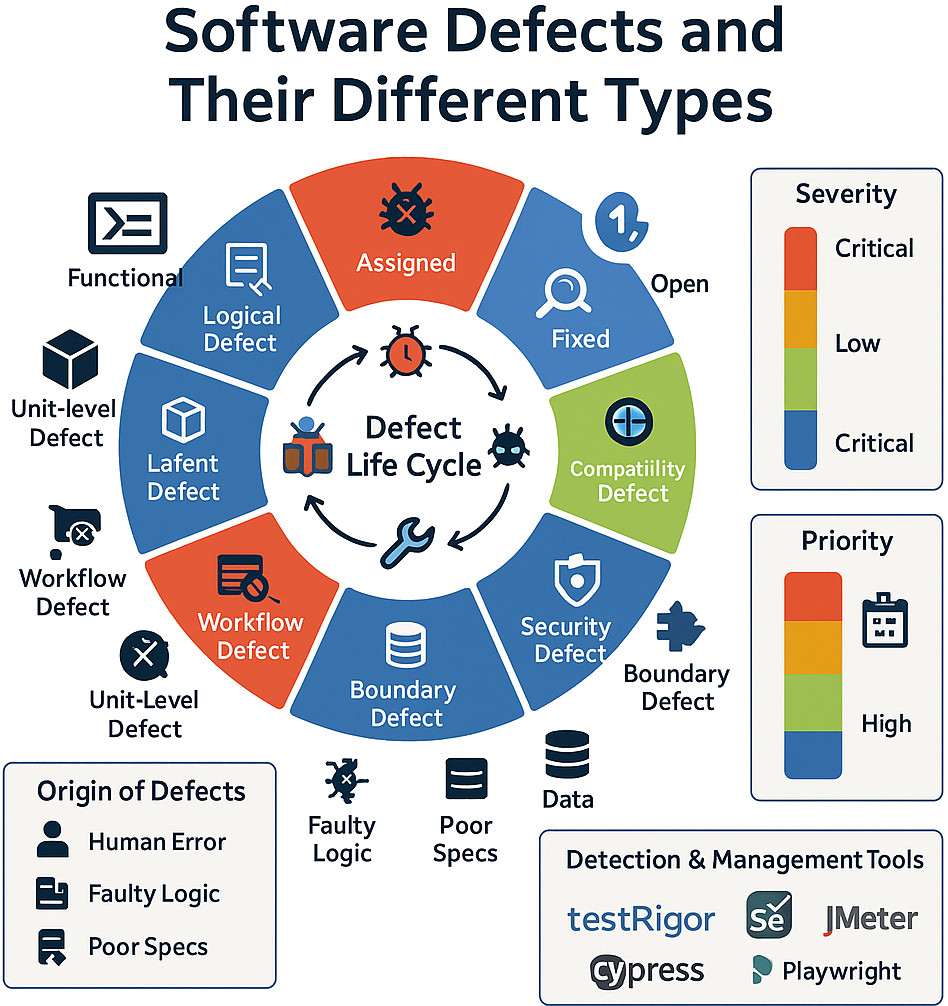
The term “defect” is not to be taken lightly in the context of software development and quality assurance; it is a critical element that influences whether software products succeed or fail. A software system’s defects, also referred to as bugs, are flaws or errors that result in incorrect or unexpected behavior. To ensure the delivery of top-notch software, testers, developers, and stakeholders must have a deep understanding of defects and the different kinds that can arise.
What is a Defect in Software Testing?
Any deviation from a software application’s predicted behavior is referred to as a defect. It can occur at any time in the software development life cycle and be brought on by incorrect requirements, faulty logic, quality of code, coding mistakes, or even human error. Defects identified during the testing process are generally documented and notified to developers for fixing. Defects can lead to subpar user experience, data loss, security breaches, and system crashes if they are not resolved at the earliest.
The most common testing types where defects are predominantly detected include unit, system, integration and user acceptance testing (UAT). To determine how urgently a defect needs to be fixed, it is usually categorized as per its priority and severity.
Types of Defects in Software Testing
Software systems can have a range of flaws. Teams can concentrate on specific areas for enhancement and accelerate the testing process by classifying them.
-
Functional DefectsThese are the most common kinds of defects. When software does not work as intended in accordance with the functional requirements, it is referred to as having functional defects. There is a functional defect, for example, if a login button does not take a user to the dashboard following successful authentication. You can use functional testing for this.
-
Logical DefectsErrors in the software’s logic are the core of logical defects. Usually, these are the consequences of faulty algorithms or incorrect code conditions. A calculator program that executes arithmetic conditions incorrectly because of a misplaced operator can be highlighted as a simple example.
-
Performance DefectsWhen software doesn’t function up to par in areas such as response time, resource usage, and load handling, performance defects emerge. An application would be reported for performance problems if it crashed when there was a high user load or took an excessive amount of time to process data. You can use performance testing for this.
-
Usability DefectsDefects in usability have a negative effect on the user experience as a whole. Although these defects might not impact the software’s functionality, they could make it annoying or challenging to operate. Unreliable UI elements, confusing navigation, or a lack of accessibility features are just a few instances.
-
Compatibility DefectsSoftware must work seamlessly on a range of devices, browsers, and platforms. When software works inconsistently in different environments, compatibility defects emerge. An instance of a compatibility defect would be a webpage that loads correctly in Chrome but crashes in Safari.
-
Security DefectsUser privacy and data integrity are seriously threatened in the presence of security flaws. These defects can lead to exploitable vulnerability, data leaks, or illegal access to the system. To maintain compliance and trust, security defects must be detected and resolved.
-
Integration DefectsWhen multiple software modules or systems don’t work properly in collaboration, it is called an integration defect. These frequently show up when testing systems or component interfaces as part of integration testing. Integration defects may include data format mismatches or API responses.
-
Boundary and Range DefectsWhen the system fails to appropriately handle values at the edge of input ranges, these defects arise. For example, input of 0 or 101 should be reported if a form accepts ages ranging from 1 to 100. Failure to handle such inputs is a boundary defect.
-
Unit-Level DefectsUnit-level defects are restricted to a specific application module or component and are detected during unit testing. These defects are often detected early in the development cycle and are usually caused by coding errors.
-
Workflow DefectsWorkflow defects are related to the order or reasoning behind the application’s operations. Enabling users to check out without adding items to their cart, for instance, is an example of a broken workflow.
-
Latent DefectsLatent defects are invisible problems that only emerge in particular scenarios, usually in a production environment, and do not emerge under normal scenarios. These can require in-depth analysis and monitoring, and are specifically difficult to detect during testing.
-
Data DefectsIncorrect or inconsistent data used or generated by the application is referred to as a data defect. Incorrect data handling in the database, losses during transfer, or subpar data mapping can all lead to this.
Classification of Defects in Software Testing Based on Priority and Severity
Software defects must be categorized as per their priority and level of severity in order to be efficiently managed:
- Severity: Highlights how deeply the defect technically impacts the application. A low-severity defect could be a minor UI error, but a critical defect could lead to system failure.
- Priority: Determines how urgently a flaw should be resolved from a business viewpoint. Although a high-priority defect may not be technically serious, it may have an impact on customer satisfaction or deadlines.
Development and QA teams can more effectively handle their time and resources while prioritizing critical problems when they are aware of their differences.
The Defects Life Cycle
Every flaw has a lifecycle, initiated from the time it is identified and ending when it is resolved. The phases of a typical defect life cycle are as follows:
- New: A defect has been reported.
- Assigned: A developer has been assigned this task.
- Open: An analysis has been initiated on the defect.
- Fixed: A resolution is put into place by the developer.
- Retest: QA verifies that the resolution has been implemented.
- Closed: The defect has been verified and closed.
Depending on the type of workflow, additional states could include “Rejected”, “Duplicate”, or “Deferred.”
Origin of Defects in Software Testing
- Inaccurate or ambiguous specifications.
- Human error in the coding process.
- Stakeholder miscommunications.
- Inefficient testing.
- Environmental or integration problems.
- Poor quality of code.
Teams can reduce defect rates in the forthcoming projects by implementing preventive measures after figuring out the underlying causes. The quality of code is extremely important when analyzing the occurrence of defects. Defects were 15× more common in low-quality code than in high-quality code.
Tools for Detecting and Managing Software Defects
The capability to identify, track, and manage defects throughout the software development life cycle can be significantly enhanced with the intervention of the appropriate tools. A few commonly used platforms and tools include:
- Selenium: An open-source web browser automation tool. Ideal for regression and functional testing.
- Cypress: A quick, modern web application testing framework that provides real-time debugging and reloading. Read more over here.
- JMeter: Leveraged to test web applications’ load and performance.
- testRigor: This no-code test automation tool facilitates testers to develop tests in plain English with bare minimum test maintenance costs. Read more over here.
- Playwright: A multi-browser compatible end-to-end testing tool for modern web applications. Read more over here.
- TestRail: A tool for handling test cases that integrates with different defect tracking platforms for in-depth QA planning. Read more over here.
Software quality can be boosted, and the QA process can be simplified by selecting the appropriate testing tools based on the type of defects being targeted.
Conclusion
Delivering superior and reliable software demands a clear comprehension of defects and their different forms. Teams can initiate testing in an organized manner by categorizing defects into performance, functional, usability, integration, and security bugs. Efficient defect management and customer satisfaction are guaranteed by prioritizing and classifying defects as per their severity and business impact.
Investing in comprehensive testing procedures and defect analysis is not an option for organizations looking to improve software quality; rather, it is a strategic demand. One of the most critical abilities in a tester’s toolbox, as software systems become more intricate, is the ability to categorize, recognize, and resolve different types of flaws.
